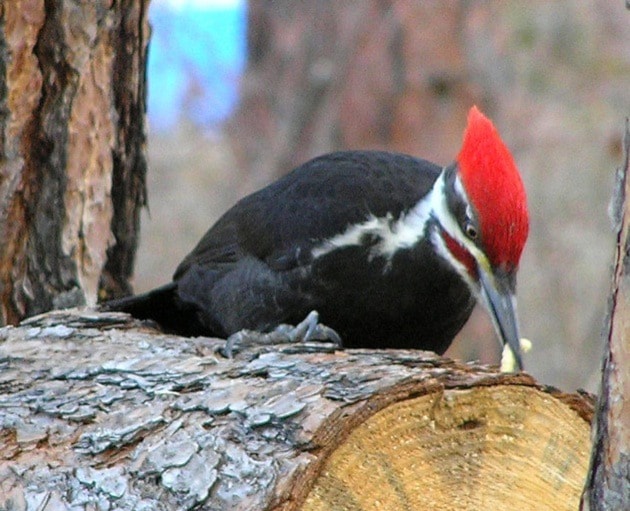Pam Laing, Okanagan birder
Just because it’s cold outside doesn’t mean birds are absent. Winter is one of the best times to see species unobscured by summer foliage. Woodpeckers are a case in point.
At only 17 centimetres, the Downy Woodpecker is our smallest woodpecker. Dainty, and with a short pointed beak with a downy tuft at its base, this bird has a white streak down the middle of its back and white spots on its black wings. Males have a red patch on the back of the head. The underside is a plain puffy white.
Downy Woodpeckers forage for food on small trees in mixed or deciduous woodland looking for any insects they can find in the crevices but also taking the occasional seed or sap. They sometimes feed on mulleins or other weedy stalks.
Very similar, but larger and with a longer beak, is the Hairy Woodpecker. This bird is about 23 to 24 cm in size; otherwise the markings are like those of the Downy Woodpecker. Hairy Woodpeckers are also found in mixed woodlands, usually in more mature, larger trees and they don’t feed on weeds. They are commoner at higher elevations than the Downy and their diet consists mainly of insects and occasional small nuts.
Our largest woodpecker is abundant year-round across Canada and much of the eastern US. At 42 cm, Pileated Woodpeckers are long-necked, broad-winged and long-tailed with a prominent red crest. Males have a red malar (or must ache) and females have a black one. They rove through mixed woodlands at all elevations and have a more varied diet than their smaller relatives due to their larger size.
Woodpecker tongues are uniquely adapted to extract their food from deep cracks in bark. They are exceptionally long, and when retracted wrap around inside the bird’s skull. The tips of their tongues are barbed and the tongue is also coated in sticky saliva to help fix their insect prey in place.
Why don’t woodpeckers get headaches when they spend so much time hammering into tree bark? Scientists have determined that woodpeckers have skulls like ‘internal bike helmets’. The birds have a special bone called a hyoid bone that wraps all the way round a woodpecker’s skull, and prevents movement of the soft brain matter inside. Woodpeckers have very strong neck muscles which help cushion any impact. They have a thick inner eyelid which closes just before impact to protect the eyes from any flying debris.
Next time you hear or see a woodpecker banging its head against a tree, you’ll appreciate all the adaptations that nature has provided to ensure the species’ health and survival.
